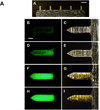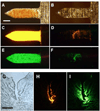Cross-protection by co-immunization with influenza hemagglutinin DNA and inactivated virus vaccine using coated microneedles
- PMID: 23643528
- PMCID: PMC3815987
- DOI: 10.1016/j.jconrel.2013.04.016
Cross-protection by co-immunization with influenza hemagglutinin DNA and inactivated virus vaccine using coated microneedles
Abstract
The need for annual revaccination against influenza is a burden on the healthcare system, leads to low vaccination rates and makes timely vaccination difficult against pandemic strains, such as during the 2009 H1N1 influenza pandemic. In an effort toward achieving a broadly protective vaccine that provides cross-protection against multiple strains of influenza, this study developed a microneedle patch to co-immunize with A/PR8 influenza hemagglutinin DNA and A/PR8 inactivated virus vaccine. We hypothesize that this dual component vaccination strategy administered to the skin using microneedles will provide cross-protection against other strains of influenza. To test this hypothesis, we developed a novel coating formulation that did not require additional excipients to increase coating solution viscosity by using the DNA vaccine itself to increase viscosity and thereby enable thick coatings of DNA vaccine and inactivated virus vaccine on metal microneedles. Co-immunization in this way not only generated robust antibody responses against A/PR8 influenza but also generated robust heterologous antibody responses against pandemic 2009 H1N1 influenza in mice. Challenge studies showed complete cross-protection against lethal challenge with live pandemic 2009 H1N1 virus. Control experiments using A/PR8 inactivated influenza virus vaccine with placebo DNA coated onto microneedles produced lower antibody titers and provided incomplete protection against challenge. Overall, this is the first study showing DNA solution as a microneedle coating agent and demonstrating cross-protection by co-immunization with inactivated virus and DNA vaccine using coated microneedles.
Keywords: Coating; Cross-protection; DNA vaccine; Influenza virus; Microneedle.
Copyright © 2013 Elsevier B.V. All rights reserved.
Conflict of interest statement
The resulting potential conflict of interest has been disclosed and is managed by Georgia Tech and Emory University.
Figures








Similar articles
-
Formulation and coating of microneedles with inactivated influenza virus to improve vaccine stability and immunogenicity.J Control Release. 2010 Mar 3;142(2):187-95. doi: 10.1016/j.jconrel.2009.10.013. Epub 2009 Oct 17. J Control Release. 2010. PMID: 19840825 Free PMC article.
-
Egg-based influenza split virus vaccine with monoglycosylation induces cross-strain protection against influenza virus infections.Proc Natl Acad Sci U S A. 2019 Mar 5;116(10):4200-4205. doi: 10.1073/pnas.1819197116. Epub 2019 Feb 19. Proc Natl Acad Sci U S A. 2019. PMID: 30782805 Free PMC article.
-
Subcutaneous immunization with baculovirus surface-displayed hemagglutinin of pandemic H1N1 Influenza A virus induces protective immunity in mice.Clin Vaccine Immunol. 2011 Sep;18(9):1582-5. doi: 10.1128/CVI.05114-11. Epub 2011 Jul 13. Clin Vaccine Immunol. 2011. PMID: 21752948 Free PMC article.
-
Microneedle-based vaccines.Curr Top Microbiol Immunol. 2009;333:369-93. doi: 10.1007/978-3-540-92165-3_18. Curr Top Microbiol Immunol. 2009. PMID: 19768415 Free PMC article. Review.
-
Novel universal influenza virus vaccine approaches.Curr Opin Virol. 2016 Apr;17:95-103. doi: 10.1016/j.coviro.2016.02.002. Epub 2016 Feb 27. Curr Opin Virol. 2016. PMID: 26927813 Free PMC article. Review.
Cited by
-
Microneedle systems for delivering nucleic acid drugs.J Pharm Investig. 2022;52(3):273-292. doi: 10.1007/s40005-021-00558-4. Epub 2022 Jan 4. J Pharm Investig. 2022. PMID: 35003824 Free PMC article. Review.
-
Noninvasive vaccination against infectious diseases.Hum Vaccin Immunother. 2018 Jul 3;14(7):1717-1733. doi: 10.1080/21645515.2018.1461296. Epub 2018 May 17. Hum Vaccin Immunother. 2018. PMID: 29624470 Free PMC article. Review.
-
Self-Assembly DNA Polyplex Vaccine inside Dissolving Microneedles for High-Potency Intradermal Vaccination.Theranostics. 2017 Jun 25;7(10):2593-2605. doi: 10.7150/thno.19894. eCollection 2017. Theranostics. 2017. PMID: 28819449 Free PMC article.
-
The Current Status of Clinical Research Involving Microneedles: A Systematic Review.Pharmaceutics. 2020 Nov 19;12(11):1113. doi: 10.3390/pharmaceutics12111113. Pharmaceutics. 2020. PMID: 33228098 Free PMC article. Review.
-
Non-dermal applications of microneedle drug delivery systems.Drug Deliv Transl Res. 2022 Jan;12(1):67-78. doi: 10.1007/s13346-021-00922-9. Epub 2021 Feb 24. Drug Deliv Transl Res. 2022. PMID: 33629222 Review.
References
-
- Gerdil C. The annual production cycle for influenza vaccine. Vaccine. 2003;21:1776–1779. - PubMed
-
- Schwartz B, Gellin B. Vaccination strategies for an influenza pandemic. J. Infect. Dis. 2005;191:1207–1209. - PubMed
-
- Subbarao K, Murphy BR, Fauci AS. Development of effective vaccines against pandemic influenza. Immunity. 2006;24:5–9. - PubMed
Publication types
MeSH terms
Substances
Grants and funding
LinkOut - more resources
Full Text Sources
Other Literature Sources
Medical

